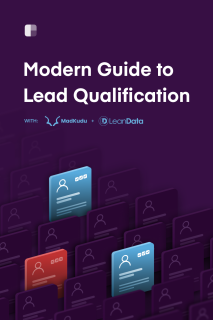Chapter 10
7 minutes
Designing the best buyer experience
The lead qualification process is what goes on behind the scenes, on the business side. But how does this affect a prospect's experience?
Good automation has a big impact, it turns out. At the most basic level, a lead goes through a qualification system and then gets to talk with a sales rep or gets email outreach.
“Lead quality and getting the right leads to the right reps can be boiled down to one word: timing. It is always the biggest challenge -- propensity to buy, automation timing, campaign timing. It's always timing.
If you can capture the right time to reach out, the right time for them to buy, and the right time to pass that lead to the right rep, you have a customer. ”

As businesses look to scale, more pieces of that system get automated, which introduces even more chances for the experience to go awry. That's why it's so important to get the tool stack right, and feed those tools with good data so that communications make sense and are helpful.
Here are some examples of software that plugs into and kicks off from scoring and routing.
Tools for engaging with leads
Automated sales engagement tools
→ example: Outreach, Salesloft
These platforms help engage with leads and customers during the buyer's journey and after the sale, via phone, social, direct mail, and video. They can incorporate data to personalize communications.
Automated meeting scheduling tools/integrations
→ example: Chili Piper Concierge, Drift Fastlane, Intercom, MadKudu Fastlane
Let qualified leads book their own sales meetings. Show an AE or SDR's calendar (or neither) based on lead score. This improves the customer experience because they don't have to wait for outreach before booking a meeting.
At this point in the buyer's journey, the way you communicate with a prospect creates their brand experience.
A bad experience looks like:
- Waiting days, weeks, or even months to get a meeting with a rep.
- Getting a canned response or a "personalized" email that's creepy or has mistakes.
- Being treated like a “new” lead when you're already familiar with the company, or being treated like a prospect when you're already a customer.
- Bouncing from person to person, SDR to AE, or territory to territory because you were routed incorrectly at first.
- Having to go through tedious qualification questions from SDRs instead of getting to the questions or demo you actually want—even if you're clearly a qualified lead.
- Receiving a really intense sales pitch or email sequence when you don't have high intent.
So as a company, how you tie your lead scoring, routing, and engagement processes together is crucial, because it can prevent these icky experiences.
Compare this to the backend system of a product: if the engineers haven't built for scale, users will notice glitches and breakdowns once the app gets popular. In the same way, leads will notice something's off when they're shopping for a tool—for example, all the emails they receive sound terrible because the company's engagement tools are cracking under the pressure of the processes and data that flows into them.
The ideal experience is a smooth journey, especially for those highly qualified prospects. A good post-score experience will have:
- Personalization: Outreach reflects the context or channel a lead came from, what they've just done, and what they need.
- Speed to lead: Relevant communications arrive promptly, providing the lead with next steps to solve their problem as quickly as possible. Don Otvos, VP of Revenue Operations at LeanData, reminds us that speed to lead isn't just quick response time, it's the right quick response: "speed to lead is having the right person respond with the right context, based on the type of campaign the lead came in on."
- Consistency: Messages come from one consistent person without unnecessary handoffs between sales team members. If handoffs happen, they're smooth and contextualized.
- Cleanliness: There's no duplicate outreach to the same person.
It's all about good timing and relevant context.
Here's LeanData's Jay Vira, Product Manager (and former Solutions Consultant), on how the undertaking of lead qualification expands expands as companies grow more advanced, from a more transactional qualification moment to building a holistic infrastructure for the whole buying experience:
Lead scoring is a critical factor in determining how to appropriately respond to a buyer. It plays into an end-to-end framework of prioritizing leads, routing them, and then automating engagement. There are so many things the buyer's doing that you want to check on before you select which reps should talk to them.
Our more advanced customers trend toward an end-to-end process automation for their go-to-market orchestration. They're not just thinking of a handoff from marketing to sales; they're thinking about the buyer experience and how to facilitate great follow-up with Salesloft and Outreach. They bring together many pieces and speed up the delivery of that experience.

Everything needs to work together just right, and these post-score communications affect all types of leads. Leads that score high go straight to the sales team for calls, emails, and more. Other leads may be on a self-serve or product-led track, where they're placed in an email nurture or onboarding sequence. Whatever the journey may be, timely and helpful automated communications can make it even better.
Fast-tracking your best leads: supercharge your website's signup forms and chat
Your website's signup forms and chat messengers can help remove friction for your best prospects. They can combine all the processes and systems we've described—automated scoring, routing, and engagement—to identify your most valuable leads and send them to sales for white-glove treatment.
One of our favorite examples comes from Gong, which enhances their signup forms with Chili Piper to shuttle leads directly to the most appropriate rep.
This is a beautiful way to boost a prospect's experience, letting them close the loop faster as they research solutions to their problems.
Another way to fast-track a lead is with personalized greetings on your website. Conversational platforms like Drift and Intercom both have capabilities and integrations that let you reach out to qualified and target accounts on your site with tailored messages. They can book meetings right away, while on the backend, the system can alert and route VIP visitors to the right rep automatically.
Here's an example from Drift: a target account revisiting a site's pricing page books a meeting directly with Chelsea, the assigned rep, without leaving the page at all. The meeting options simply show up in the chat.

And here's another example, this time from Intercom, where the assigned AE, Ashley, automatically introduces herself to a visiting target account via a personalized message on the site.

MadKudu's Fastlane qualifies leads when they're filling out a form, giving high-value leads an option to book a meeting directly with sales. (It also offers integrations with Intercom and Drift to personalize chat to fast-track the best leads.)
 MadKudu Fastlane qualifies leads in real time, as soon as they share their email address.
MadKudu Fastlane qualifies leads in real time, as soon as they share their email address.With all these tools available, it's never been easier to create a slick experience for your best prospects. Why bother, you ask? Well, since most companies botch this, you'll really stand out if you get it right. Getting your tech stack right is great for both your customers and your reps, because it can initiate relationships that are clear, neat, and solve problems quickly — and broker good deals.


